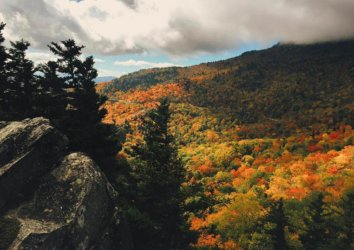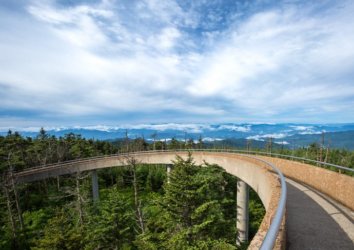When we think of wildfires in the United States, our minds often drift to the American West, from the Rockies (host to the 1988 Yellowstone fires, for example) to the highly flammable chaparral brushlands of California. More eastern portions of the country aren’t as closely associated in popular conception with wildfires. Yet fire is an important—even essential—component to many ecosystems here as well. And, on the flipside, fire danger can also be significant in the East, with the potential for large and destructive blazes that threaten human life and property and transform landscapes.
The Great Smoky Mountains are famed for their lushness and high rainfall, not necessarily ingredients we link with burning. But this magnificent mountain range of the Southern Appalachians also bears the time-honored stamp of wildfire. The large and deadly Gatlinburg, Tennessee fires of 2016 forced many to view the Smoky Mountain country as a fire scape.
Catastrophic wildfires certainly aren’t common in the Great Smokies, and in fact, lower-intensity burns are increasingly recognized as important in maintaining particular habitats and supporting particular species. Let’s dig into the story of wildfires in the Smoky Mountains for more perspective on this natural disturbance—and run through some of the elements of being a conscientious, fire-safe visitor.
Wildfires in the Great Smoky Mountains
Historical observations and tree-ring and other scientific research all highlight the significance of occasional wildfires in the Southern Appalachians. Drier habitats within these mountains, such as pinewoods and pine-oak forests, have likely historically burned the most frequently. Wetter cove hardwood forests and high, cool spruce-fir forests would have generally burned much less often.
Both historical and modern wildfires in the Great Smoky Mountains and elsewhere in the Southern Appalachians may be caused by lightning. The massive block of high terrain makes summer thunderstorms a common occurrence in the Smokies. The National Park Service reports that two lightning-sparked wildfires occur in Great Smoky Mountains National Park each year on average. They’re most likely in May and June.
Lightning may not immediately cause a large wildfire, especially when it comes amid decent rainfall. Rather, it may produce a burning tree or smoldering area of duff that, when later exposed to hot, dry weather, can flame more intensely and spread fire to surrounding vegetation.
Native North Americans also intentionally started fires in some areas for a variety of purposes, including clearing underbrush for better travel or sightlines, drawing game animals in for fresh post-fire growth, and the propagation of certain kinds of plants. Early Euro-American settlers adopted some Native burning practices to, for example, clear and maintain the pasture.
Lightning or the human hand may cause the direct ignition of a wildfire in the Great Smokies, but broader environmental conditions make the spread and sustenance of that wildfire more or less likely. A period of drought or a stretch of windy weather with low relative humidity can make wildfire spread more likely.
The Importance of Wildfire in Great Smoky Mountain Ecosystems

Wildfires create many important benefits to the landscape, including clearing choking overgrowth and brush and adding nutrients to the soil. Open woodlands of pine, oak, or hickory may depend on fire for long-term presence on the landscape, as in some settings they’d otherwise be invaded and overtaken by more dense-growing, shade-tolerant trees.
Along with ecosystems themselves, many species in the Southern Appalachians are dependent on fire. Cones of the Table Mountain pine, for example, open in the heat of a wildfire and spread seeds that prosper on the burned ground. Red-cockaded woodpeckers prefer to nest in large pines clear of encroaching underbrush, which can make it easier for predators to raid the nests.
By helping maintain oak forests on Smoky Mountain slopes and ridgetops, wildfire ensures a productive supply of acorns. This “hard mast” is a major food source for all kinds of native wildlife, from wild turkeys and squirrels to white-tailed deer and black bears.
The early 20th century saw land managers across the U.S. actively suppress any wildfires, which were then widely viewed as mainly a source of destruction. Decades of fire suppression in the Great Smokies have resulted in declines in fire-dependent ecosystems and species (including the Table Mountain pine and red-cockaded woodpecker), and an increase in fire-sensitive species such as red maples and eastern hemlock.
Modern Fire in the Great Smokies

Recognizing the importance of wildfire in the mountains, the Park Service began easing back on total fire suppression in the Great Smokies in roughly the 1970s. Today, prescribed burning—intentionally set fires that are carefully controlled—is used for particular management objectives. Prescribed burns are used, for example, to help maintain the open fields of Cades Cove. Additionally, lightning-sparked fires in the park’s deep backcountry may be allowed to burn if they’re deemed unlikely to spread into developed or otherwise at-risk locations.
Besides benefiting particular habitat types and organisms, prescribed burns and acceptable wildland fires can also protect park resources and development by reducing the excessive buildup of heavy fuel that could create a much larger, uncontrollable conflagration under the right conditions.
Preventing Undesirable Fires in Great Smoky Mountains National Park

Close to 85 percent of all wildland fires in the U.S. today are caused by people. We’ve emphasized how ecologically beneficial fire can be in the Great Smokies, but it’s important to stress that not all wildfires are desirable by any means. Overgrowth resulting from a legacy of fire suppression, an increasing number of homes in the so-called “wildland-urban interface” near the park, and other realities of the modern landscape can produce fires larger or more destructive than historical blazes.
Along with downed power lines, sheer negligence and carelessness are prime culprits when it comes to human-caused fires. Cigarette butts tossed into leaf litter or grass can spark a wildfire; so can sparks from automobiles driven over such surfaces. And campfires that aren’t carefully monitored and managed—or that are set at inappropriate times—are a notorious cause of wildfires. Criminal arson is, sadly, an element in many cases as well.
Pay heed to any fire advisories during your visit to the Great Smokies or surrounding forestlands. During periods of dry, hot, and/or windy weather, campfires and other burning may be limited or outright prohibited. Be careful using, and properly disposing of, matches, cigarettes, and other potential sources of ignition.
Use common sense and follow up-to-date regulations to ensure you won’t be the cause of any unintended flareups in the forests of the Great Smokies!




